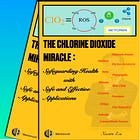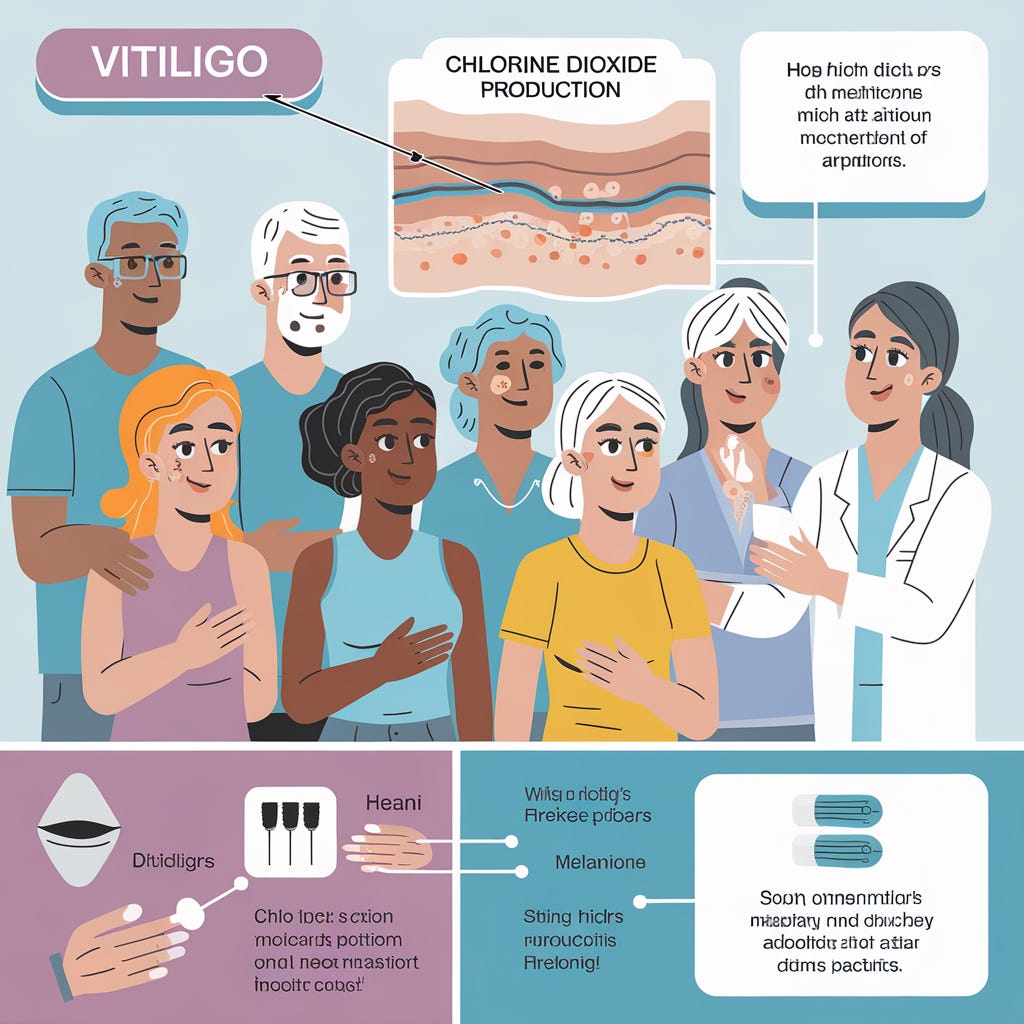This excerpt is from my book, "The Chlorine Dioxide Miracle: Safeguarding Health with Safe and Effective Applications." If you're interested in chlorine dioxide therapy, you can purchase the book here:
12.1 Treating Vitiligo with Chlorine Dioxide
Vitiligo is a common chronic skin condition characterized by varying sizes of white patches on the skin, caused by the loss of pigment cells (melanocytes). It affects about 0.5% to 2% of the global population and does not discriminate by race, gender, or age; anyone can develop the condition.
The exact cause of vitiligo is not fully understood, but research suggests that multiple factors may play a role, including genetic predisposition, autoimmune reactions, neurochemical factors, and environmental triggers. The autoimmune hypothesis, which proposes that vitiligo occurs when the immune system mistakenly attacks and destroys healthy melanocytes, is widely accepted. Additionally, evidence suggests a link between vitiligo and other autoimmune diseases such as thyroid disorders, diabetes, and pernicious anemia.
Clinically, vitiligo presents as one or more circular or irregularly shaped white patches on the skin with usually distinct edges, and hair in the affected area may also turn white. These patches are most commonly found on the face, hands, and torso, particularly in areas frequently exposed to the sun. While vitiligo does not cause physical pain or direct health issues, it can significantly impact the psychological and emotional well-being of patients, leading to reduced self-esteem and social difficulties.
Diagnosis typically involves clinical examination, and a doctor may use an ultraviolet lamp to inspect the skin and identify white patches. In some cases, a skin biopsy or blood tests may be necessary to rule out other potential causes.
The goal of treating vitiligo is to restore skin color. Although there is no cure, various treatments can help manage the condition and improve appearance. Treatment options include:
(1) Medications: Topical creams such as corticosteroids, immunomodulators, or other drugs to promote pigment restoration.
(2) Phototherapy: Ultraviolet light exposure, particularly narrow-band UVB therapy, can stimulate melanocyte activity.
(3) Laser Treatment: Excimer lasers are effective for small areas of vitiligo.
(4) Skin Grafting: For some patients with resistant vitiligo, transplanting normal pigmented skin to depigmented areas may be considered.
(5) Cosmetics: Concealers and self-tanners can be used to cover white patches.
Clearly, as an autoimmune skin disease, vitiligo treatment, such as phototherapy, appears to utilize the function of ROS, since phototherapy generally produces ROS. Therefore, I surmise that by using chlorine dioxide to mimic ROS, vitiligo can be effectively treated as well.
I treated a case of vitiligo with chlorine dioxide, and as seen
in the images, the results were significant (Figure 13).
The mechanism by which chlorine dioxide works in treating vitiligo is similar to its action in treating psoriasis. It regulates the immune system’s abnormal response, reducing self-attack on the skin and thereby alleviating symptoms. Specifically, the mechanism of chlorine dioxide treatment for vitiligo may include the following aspects:
(1)- Clearing misidentified antigens: Chlorine dioxide may help eliminate antigens that the immune system has mistakenly identified as abnormal, which are key factors in the pathogenesis of autoimmune skin diseases.
(2)- Modulating signaling pathways: Chlorine dioxide might assist in adjusting the immune system’s signaling pathways, signaling to the immune system that foreign substances have been cleared, which helps to stop the immune system’s continuous attack on its own tissues.
(3)- Reducing hyperactivity of the immune system: By diminishing the immune system’s overactivity, chlorine dioxide may help lessen inflammatory responses and potentially restore the immune system’s normal balance.
12.2 Vitiligo Treatment Protocol
A. Preparing Chlorine Dioxide:
Weigh 100 grams of sodium chlorate solid (powder with 80% purity, the remaining 20% being sodium chloride) and dissolve it in 900 milliliters of deionized water (or distilled water). Heat the mixture to about 50 degrees Celsius until the solid is completely dissolved, then cool to room temperature to create an 8% sodium chlorate solution.
Weigh 200 grams of citric acid solid (analytically pure with 99.9% purity), and dissolve it in 800 milliliters of deionized water (or distilled water). Heat the mixture to about 50 degrees Celsius until the solid is completely dissolved, making a 20% citric acid solution.
Mix equal volumes of the two solutions and wait for about 5 minutes to produce an acidic chlorine dioxide saturated solution (about 3000ppm, or 3mg/mL).
B. Storing Chlorine Dioxide:
Since chlorine dioxide easily evaporates from water, it is generally recommended to prepare it on-site as needed. If a larger quantity must be prepared and stored for an extended period, it should be kept in a glass bottle in the refrigerator at 2-8 degrees Celsius.
C. Treatment Methods for Psoriasis:
Apply the acidic chlorine dioxide solution gently on the affected areas of vitiligo with a cotton swab. For specific cases of vitiligo, apply once daily and continue for 10-20 days, then wait for the psoriasis to recover. Vitiligo might not be cured within one cycle; a second course of treatment can be continued 10-30 days after the previous one ends.







Hello good evening,I bought the 2 bottle pack ( CD + HCL ) in Amazon. As per Doc Lee Merritt . You start with one drop and bring it gradually to 10-15 drops per bottle of water concentration. She says 25 drops is cancer treatment level. If I have someone with flu symptoms I use 3 drops and in 24 hrs there’s cured . All this is drinking it . One drink every hour all day long . What would be the recommended amount of drops I should use for vitiligo, have a long time friend that has it and I would like to help ! Please advise. Thank you kindly, Daniela DC
Very good. I wonder if the CLO2 is also increasing cellular voltage to an optimal -25mv/7.45 pH and -50mv to repair the cells.